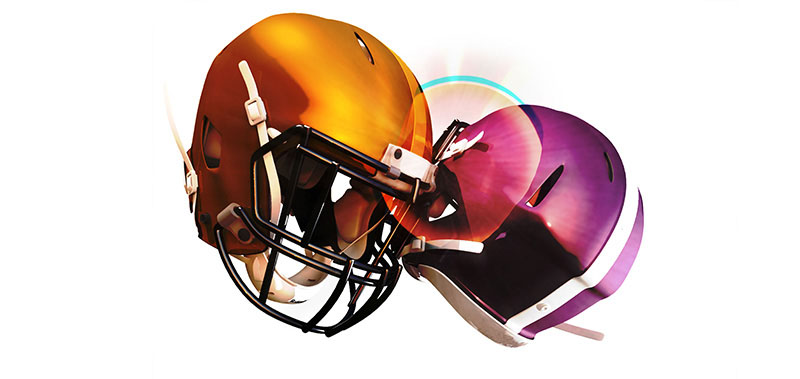Is this the safe football helmet of the future?
From our special report on innovation


Football has a big problem. These days, a good chunk of parents — about 40 percent, according to one poll — are discouraging their kids from participating in one of America's most popular (and most lucrative) sports. Why? Football has been linked to dangerous head injuries, most notably chronic traumatic encephalopathy, a degenerative disease caused by repetitive hits to the head. In one study examining the brains of deceased NFL players, a whopping 96 percent showed signs of CTE, which has been linked to depression and memory loss.
So, what's to be done? Safer helmets would be ideal, but for current models to truly protect a player's noggin, they would need to crack upon impact, like a bicycle helmet does, absorbing the energy before it ripples through the skull. That's not particularly sustainable or cost effective, especially when players are taking hits so frequently. In a single season, a professional football player could sustain up to 1,500 blows to his head. That's 1,500 helmets that would need to be replaced, just for one player.
A group of researchers from the University of Michigan have set out to find a solution. Thanks to funding from the NFL, Under Armour, GE, and the National Institute of Standards and Technology, they've created a helmet prototype called the Mitigatium designed to absorb and dissipate energy using the laws of physics. It blocks something called "impulse" — basically, the amount of forced multiplied by the amount of time it was exerted on the subject.
The Week
Escape your echo chamber. Get the facts behind the news, plus analysis from multiple perspectives.

Sign up for The Week's Free Newsletters
From our morning news briefing to a weekly Good News Newsletter, get the best of The Week delivered directly to your inbox.
From our morning news briefing to a weekly Good News Newsletter, get the best of The Week delivered directly to your inbox.
The Mitigatium has three main components, which researchers say "amount to more than the sum of their parts." The first layer is hard, like the shells of current helmets. Beneath that lies a flexible plastic that works with the top layer to reflect the shock wave from a hit to the head. The real magic lies in the third layer, a material that's similar to the stuff you'd find in a memory foam mattress, but slightly tougher. This third layer takes the remaining wave of pressure and "dissipates it by vibrating." In tests, the new helmet reduced impulse by 80 percent compared to conventional helmets.
"We've come up with a totally new concept of how to make efficient impact-mitigating structures that could dissipate energy without being damaged," said Michael Thouless, one of the project leaders. "And we used basic concepts of mechanics to develop a fundamental understanding of how to protect delicate structures such as the brain."
There are certainly hurdles to overcome for the researchers. For one, the football helmet marketplace is dominated by two big companies that claim 90 percent of the business and have been known to sue competitors for patent infringement. And there are other newbies in the marketplace. A startup named Vicis has created a helmet called Zero1, which comes with an outer layer that crumples, and an inner layer that's hard. "Like a car's bumper, the softer carapace gives a little when struck, slowing the impact before it reaches a tailback's brain," says Bloomberg.
Mitigatium has potential applications off the football field, too. Its materials could be tweaked to withstand different kinds of impact and be used, for example, by members of the military out in the field. But it has to get beyond its prototype stage first.
A free daily email with the biggest news stories of the day – and the best features from TheWeek.com
Jessica Hullinger is a writer and former deputy editor of The Week Digital. Originally from the American Midwest, she completed a degree in journalism at Indiana University Bloomington before relocating to New York City, where she pursued a career in media. After joining The Week as an intern in 2010, she served as the title’s audience development manager, senior editor and deputy editor, as well as a regular guest on “The Week Unwrapped” podcast. Her writing has featured in other publications including Popular Science, Fast Company, Fortune, and Self magazine, and she loves covering science and climate-related issues.
-
 7 bars with comforting cocktails and great hospitality
7 bars with comforting cocktails and great hospitalitythe week recommends Winter is a fine time for going out and drinking up
-
 7 recipes that meet you wherever you are during winter
7 recipes that meet you wherever you are during winterthe week recommends Low-key January and decadent holiday eating are all accounted for
-
 Nine best TV shows of the year
Nine best TV shows of the yearThe Week Recommends From Adolescence to Amandaland
